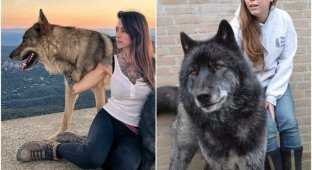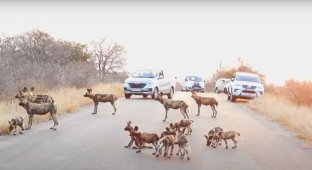Democracy in African style: what do wild dogs decide when the whole pack gathers and starts sneezing (4 photos)
There are serious contradictions when defining representatives of the animal world. For example, this rather cute eared creature is called a hyena or hyena-like dog. However, it must be taken into account that despite the external similarity, hyenas have nothing to do with this animal. 
They belong to the felid species, while wild dogs are canids. This is evidenced by their scientific name - Lycaon pictus, literally translated: “painted wolf”. 
Photo source: animaljournal.ru
This is true, although hyena dogs are more likely to resemble coyotes or jackals rather than wolves. But according to DNA, their closest relatives are red wolves, which live in Southeast Asia. This wolf is called “painted” due to the fact that its entire body is covered with bizarre spots of black, white or reddish-brown. However, there are also completely black or red individuals that do not have any spots.
The habitat of hyena dogs is considered to be eastern and southern Africa; almost half of the individuals are found in the Republic of South Africa (RSA). They are also widespread in Kenya, Namibia, Tanzania, Uganda, Zimbabwe and other African countries. These are pack animals that engage in driven hunting. The number of individuals in a pack can number a hundred, although most often there are associations of up to 30 dogs.
The pack lifestyle involves constant communication between members of the “gang”. They need to coordinate their actions and distribute roles in the hunting process. And these predators like to attack not only peaceful and small antelopes. A pack can compete in strength even with a buffalo, but most of all, like all dogs, dogs do not like cats, which is why they often attack cheetahs and lions. In some cases it is quite successful. After all, according to experts, hyena-like dogs have the strongest and largest teeth among all canines. 
Photo: koshka.top
Communication within the pack occurs through barking, but hyena dogs express important decisions by sneezing. In this case, the leader (often an old, experienced female) is the last to express her opinion. After listening to the sneezing of all his relatives, he confirms the decision with a short sneeze, to which the whole flock listens. After this, the roles for the next hunt are distributed by the usual barking and even biting each other. In this way, the strongest and most courageous members of the community are identified.
It is interesting that these representatives of the canid genus do not like the African jungle, preferring steppes and semi-deserts, bush areas and foothills. Being school animals, they move long distances following potential prey. However, they do not set up temporary housing. After all, it is much easier to occupy already inhabited places, driving out the previous owners from them.
This way of life explains the body structure of animals. These are dry, lean predators with long legs and large ears. Their height at the withers reaches 80 centimeters, body length – up to 1.5 meters, tail – up to 50 cm, body weight – up to 36 kg. They have 4 toes on their front paws with powerful claws. Wild dogs can be identified by their characteristic “dog-like” musky odor. Sensitive animals quickly react to this and prefer not to get involved with the pack, prudently leaving their habitats. 
Photo: travelask.ru
So hyena dogs have little prey today. It is no coincidence that they have already been included in the Red Book as a gradually disappearing species. The decline in population is directly related to human activities, which is why their traditional habitat is shrinking. Their shooting by local farmers is also considered common practice. To this it is worth adding attacks on animals that have strayed from the pack by predators - cheetahs and lions. So there is a serious threat of complete extinction of these animals.
























